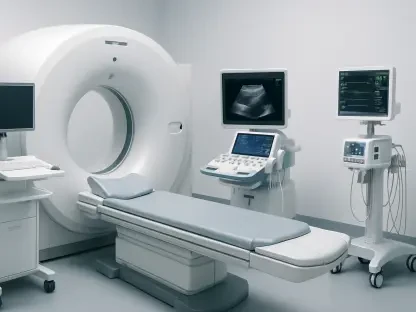The healthcare industry finds itself at a critical juncture, with unprecedented investments in artificial intelligence (AI), the Internet of Medical Things (IoMT), and remote patient monitoring systems reshaping the landscape of patient care. These technologies hold immense promise, offering advanced analytics, wearable devices, and real-time data processing to enhance diagnostics and treatment. Yet, a pressing concern overshadows this digital surge: the outdated IT infrastructure in many hospitals and health systems struggles to support such rapid innovation. Research from HIMSS Market Insights underscores a stark disparity between ambitious financial commitments and the foundational systems needed to sustain them. This gap threatens not only the billions of dollars being funneled into these advancements but also the potential for transformative improvements in patient outcomes and operational efficiency. As the sector races toward a tech-driven future, the ability to modernize infrastructure emerges as a defining challenge.
The Scale of Investment and Infrastructure Gap
Rising Investments vs. Lagging Systems
The financial stakes in healthcare technology are staggering, with projections estimating AI investments to reach $149 billion by 2030 and IoMT expenditures expected to soar to $814 billion by 2032, highlighting the immense potential for transformation in the sector. Remote patient monitoring systems alone are forecasted to hit $78 billion by 2029. These figures reflect a bold vision for healthcare, where AI-driven analytics predict patient needs, IoMT connects medical devices for seamless data sharing, and remote systems enable care beyond hospital walls. However, the reality on the ground paints a different picture. Many healthcare organizations operate on legacy IT systems that struggle under the data-intensive demands of these innovations. This infrastructure deficit acts as a bottleneck, risking the waste of massive investments and stalling progress. If left unaddressed, the disconnect between cutting-edge tools and outdated foundations could undermine the very goals these technologies aim to achieve.
A deeper look reveals that the implications of this gap extend beyond financial losses, impacting the very core of healthcare’s mission—patient care—which hangs in the balance as systems struggle to integrate new tools effectively. For instance, without robust infrastructure, AI models may fail to process real-time data for critical diagnoses, and IoMT devices could encounter delays or security lapses. Hospitals and health systems face mounting pressure to align their IT capabilities with the scale of their digital ambitions. The challenge is not merely technical but strategic, requiring a fundamental overhaul of how resources are allocated and prioritized. Industry reports consistently highlight that the failure to modernize risks diminishing returns on investment, leaving organizations unable to capitalize on technologies that could revolutionize care delivery. Bridging this divide is essential to ensure that the promise of digital transformation translates into tangible benefits for patients and providers alike.
Financial Risks and Operational Setbacks
Beyond the sheer scale of investments, the financial risks tied to inadequate infrastructure loom large for healthcare organizations. Billions of dollars are at stake, and the inability to support AI and IoMT tools with reliable systems could lead to significant losses. Operational inefficiencies compound the problem, as outdated networks struggle to handle the volume and speed required for real-time analytics or comprehensive electronic health records (EHRs). Such limitations not only hinder the adoption of new technologies but also disrupt existing workflows, creating delays in care delivery and increasing costs. The ripple effect is felt across the board, from reduced staff productivity to compromised patient experiences, highlighting the urgent need for systemic upgrades to prevent these setbacks from derailing progress.
Moreover, the operational challenges are intertwined with broader systemic issues that demand attention, particularly in the healthcare sector where disparities are evident. Many healthcare facilities, especially smaller or rural ones, lack the capital to invest in necessary IT upgrades, creating disparities in digital readiness across the sector. This uneven landscape means that while some organizations may push forward with cutting-edge implementations, others lag behind, potentially widening gaps in care quality. The financial burden of maintaining outdated systems while attempting to integrate new technologies further strains budgets, forcing tough decisions on where to allocate limited funds. Addressing these risks requires not just investment but a strategic vision that prioritizes infrastructure as a cornerstone of digital success. Only by tackling these operational and financial hurdles can the industry hope to realize the full potential of its technological commitments.
Challenges in Network and Connectivity Demands
Bandwidth Limitations and Network Complexity
The rapid adoption of AI and IoMT technologies has exposed severe limitations in traditional healthcare networking capabilities, particularly with outdated 10-gigabit connections that cannot meet current data demands. Real-time analytics, comprehensive EHR systems, and connected medical devices require significantly higher bandwidth, with industry experts advocating for a shift to 100-gigabit capacity as a baseline. This upgrade is no longer a luxury but a necessity to ensure seamless data flow across complex healthcare environments. The intricacy of modern networks, which must support hospital-issued devices, personal gadgets, and smart equipment in both urban and remote settings, adds another layer of difficulty. Traditional designs are ill-suited for this expanded scope, necessitating innovative approaches to connectivity that can adapt to diverse and dynamic needs.
Additionally, the concept of a network perimeter has fundamentally changed as healthcare delivery extends beyond physical hospital boundaries, demanding flexible and robust solutions to maintain performance across varied locations. Providing care to remote and metropolitan populations requires IT systems to adapt to this shift, as networks must now accommodate a growing array of endpoints while ensuring reliability and speed. The complexity is compounded by the need to integrate disparate systems into a cohesive framework that supports everything from telemedicine to wearable health monitors. Without addressing these bandwidth and structural limitations, healthcare organizations risk persistent disruptions that could compromise patient care at critical moments. Modernizing network infrastructure is thus a pivotal step toward sustaining the digital tools that promise to reshape the industry.
Adapting to Distributed Care Models
The move toward distributed and patient-centric care models further amplifies the connectivity challenges facing healthcare. As services expand to include remote consultations and home-based monitoring, networks must support a diverse ecosystem of devices and users outside traditional settings. This evolution requires infrastructure that can handle increased data traffic while maintaining uptime and accessibility, regardless of geographic barriers. The ability to deliver consistent care through digital platforms hinges on creating systems that are both scalable and resilient, capable of adapting to spikes in demand or unexpected technical issues. Such adaptability is crucial to ensuring that technology serves as a bridge rather than a barrier to equitable healthcare access.
Equally important is the need to balance connectivity with operational stability in these distributed models. The integration of IoMT devices, such as wearable sensors and smart medical equipment, generates vast amounts of data that must be processed and stored efficiently. Without adequate network support, delays or failures in data transmission could lead to gaps in patient monitoring or treatment plans. Healthcare organizations must therefore prioritize investments in infrastructure that can sustain this data-intensive environment while enabling seamless communication between providers and patients. This focus on robust connectivity not only supports current innovations but also lays the groundwork for future advancements in personalized and accessible care delivery.
Shifting Perspectives on IT Investments
From Cost to Value in Healthcare IT
Historically, IT infrastructure in healthcare has been viewed as a cost center, often relegated to the bottom of budget priorities. However, a significant shift is underway as chief information officers (CIOs) reframe IT as a driver of value, directly linked to improved patient care and operational efficiency. This change in perspective is driven by the recognition that robust systems are essential to unlocking the potential of AI, IoMT, and remote monitoring tools. CIOs now face the task of justifying infrastructure upgrades by demonstrating measurable outcomes, such as faster diagnoses or streamlined workflows. This value-based approach marks a departure from traditional cost-cutting mindsets, placing technology at the heart of strategic planning to enhance both clinical and administrative functions.
The human stakes of this shift cannot be overstated, as every IT decision ultimately impacts patients’ lives, and a delayed system update might mean slower access to critical health data. A successful upgrade, on the other hand, could enable life-saving interventions through real-time analytics. Industry leaders emphasize that aligning IT investments with patient outcomes is not just a financial argument but a moral imperative. This evolving mindset requires a cultural change within organizations, encouraging collaboration between technical teams and clinical staff to ensure that technology serves the needs of those it is meant to help. By focusing on value over cost, healthcare systems can better position themselves to leverage digital tools for meaningful improvements, ensuring that investments translate into real-world benefits.
Strategic Alignment for Better Outcomes
Aligning IT investments with strategic goals is becoming a cornerstone of healthcare transformation, as organizations seek to maximize the impact of their technological advancements. This alignment involves more than just funding upgrades; it requires a clear vision of how infrastructure supports broader objectives like enhancing care quality and reducing operational bottlenecks. For instance, investing in systems that enable seamless data sharing across departments can improve coordination and reduce errors, directly benefiting patients. Such strategic planning demands input from diverse stakeholders, including clinicians, administrators, and IT specialists, to ensure that technology addresses real challenges rather than creating new ones.
Furthermore, the focus on outcomes-driven investments highlights the need for accountability and metrics to track success. Healthcare organizations must establish benchmarks to evaluate how IT upgrades contribute to efficiency gains or patient satisfaction, moving beyond vague promises of improvement. This data-driven approach helps build a compelling case for continued funding, demonstrating to boards and investors the tangible returns of infrastructure modernization. As the industry grapples with balancing innovation and stability, strategic alignment offers a roadmap for ensuring that every dollar spent on IT contributes to a stronger, more responsive healthcare system. This forward-thinking perspective is essential to navigating the complexities of digital adoption in a high-stakes environment.
Cybersecurity in an Expanding Digital Landscape
Securing the New Perimeter
As healthcare networks become increasingly distributed with the rise of edge computing and connected devices, cybersecurity risks have escalated dramatically, reshaping the landscape of data protection. The traditional hub-and-spoke architecture is giving way to models that push data processing closer to the point of care, expanding the so-called attack surface. This shift redefines security as the new perimeter, where every endpoint—be it a wearable device or a hospital tablet—becomes a potential vulnerability. To counter these threats, healthcare organizations are adopting advanced frameworks like zero trust architecture, which assumes no user or device is inherently safe and requires continuous verification. Such measures are critical to protecting sensitive health data in an environment where breaches can have devastating consequences.
The urgency of robust cybersecurity is further heightened by the sheer volume of data generated by IoMT and remote monitoring systems, emphasizing the need for advanced protective measures. Each connected device represents a possible entry point for malicious actors, making traditional device-level security insufficient. Modern strategies prioritize individual user authentication through multi-factor methods and ongoing access checks, ensuring that only authorized personnel interact with critical systems. This evolution reflects the growing complexity of safeguarding information in an interconnected world, where a single lapse can compromise patient trust and organizational integrity. Investing in these advanced protections is not just a technical necessity but a fundamental responsibility to maintain the confidentiality and safety of health records.
Adapting to Evolving Threats
The dynamic nature of cyber threats in healthcare demands constant adaptation, as attackers exploit new vulnerabilities created by expanding digital ecosystems. Ransomware, phishing, and other sophisticated attacks target the vast troves of personal data stored in healthcare systems, often with crippling results. Organizations must therefore stay ahead of these risks by regularly updating security protocols and investing in threat intelligence to anticipate emerging dangers. This proactive stance is essential to mitigate disruptions that could halt operations or endanger patient care, especially as reliance on digital tools continues to grow. Staying vigilant in this ever-changing landscape is a non-negotiable aspect of infrastructure modernization.
Equally critical is the need to educate staff and stakeholders about cybersecurity best practices, as human error remains a leading cause of breaches, and addressing this can significantly strengthen defenses. Training programs that emphasize recognizing suspicious activity and adhering to strict access protocols can greatly reduce risks. Additionally, partnerships with cybersecurity experts can provide healthcare organizations with the specialized knowledge needed to combat advanced threats. These collaborative efforts help build a multi-layered defense that protects against both internal and external dangers. As the digital landscape evolves, so too must the strategies to secure it, ensuring that patient data remains safe amid the rapid integration of AI and IoMT technologies. This ongoing commitment to security is vital for sustaining trust and functionality in a connected healthcare future.
Resource Constraints and External Solutions
Leveraging Managed Service Providers
Many healthcare organizations face significant resource constraints when it comes to scaling their IT infrastructure, often lacking the in-house expertise or budget to manage complex digital transformations. This shortage of internal capabilities poses a major barrier to keeping pace with the demands of AI and IoMT implementations. Enter managed service providers, which have emerged as a practical solution by offering specialized support to optimize systems without overextending limited resources. These external partners bring technical know-how and scalable services, enabling hospitals to modernize infrastructure cost-effectively. Such collaborations allow healthcare entities to focus on their core mission of patient care while outsourcing the heavy lifting of IT management to capable hands.
The benefits of partnering with managed service providers extend beyond mere technical support, offering a strategic advantage in a competitive landscape. These providers can tailor solutions to specific organizational needs, whether it’s enhancing network capacity or bolstering cybersecurity measures. This flexibility is particularly valuable for smaller or underfunded facilities that might otherwise struggle to adopt cutting-edge technologies. By leveraging external expertise, healthcare systems can achieve sustainable progress, ensuring that infrastructure keeps up with innovation without draining internal budgets. This approach not only addresses immediate resource gaps but also builds a foundation for long-term digital resilience, helping organizations navigate the complexities of a tech-driven future with confidence.
Building Capacity Through Collaboration
Collaboration with external partners offers more than just a quick fix for resource shortages; it fosters a pathway to building long-term capacity within healthcare organizations. Managed service providers often work alongside internal teams, transferring knowledge and skills that empower staff to handle future challenges more effectively. This capacity-building aspect is crucial for creating a self-sustaining IT environment where organizations are less dependent on constant external intervention. By investing in these partnerships, healthcare systems can gradually develop the expertise needed to manage sophisticated technologies, ensuring that infrastructure evolves in tandem with digital advancements over time.
Moreover, these collaborative efforts help address disparities in technological readiness across the sector, particularly for rural or smaller facilities with limited access to talent and funding. External providers can offer standardized solutions that level the playing field, allowing all organizations to benefit from modern infrastructure regardless of their starting point. This democratization of access to cutting-edge support is vital for ensuring equitable care delivery, as it prevents technological gaps from translating into disparities in patient outcomes. As the industry continues to grapple with resource limitations, such partnerships stand out as a pragmatic way to bridge the divide, paving the way for a more inclusive and robust healthcare ecosystem.
Closing Thoughts on Bridging the Digital Divide
Reflecting on the infrastructure crisis that gripped healthcare, it became evident that the massive investments in AI, IoMT, and remote patient monitoring had outpaced the systems meant to support them, revealing significant gaps in readiness. The challenges of outdated networks, cybersecurity vulnerabilities, and resource shortages posed formidable barriers to progress. Yet, the industry’s response through strategic shifts—reframing IT as a value driver and embracing managed service providers—marked a turning point. Looking ahead, healthcare leaders must prioritize actionable steps, such as accelerating infrastructure upgrades and fostering partnerships, to ensure technology serves its purpose. Investing in scalable, secure systems and ongoing staff training will be key to sustaining innovation. By addressing these foundational gaps now, the sector can build a resilient framework that not only supports current advancements but also anticipates future needs, ultimately securing better care for all.









